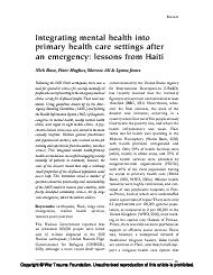Integrating mental health into primary health care settings after an emergency: lessons from Haiti
Following the 2010 Haiti earthquake, there was a need for specialist services for severely mentally ill people who were presenting to the emergency medical clinics set up for displaced people. That need was unmet. Using guidelines drawn up by the Inter Agency Standing Committee (IASC) and piloting the Health Information System (HIS) of diagnostic categories in mental health, weekly mental health clinics were begun in eight mobile clinics. A psychiatric liaison service was also started in the main casualty hospital. Haitian general practitioners and psychosocial workers, who received on-the-job training and supervision from the authors, ran these services. This integrated mental health/primary health care model was successful in engagingseverely mentally ill patients in treatment; however, the scale of the disaster meant that only a relatively small proportion of the displaced population could access help. This limitation raised a number of questions about the practicality and sustainability of the IASC model in resource poor countries, with poorly developed community services, hit by large scale emergencies, which the authors address
Geachte bezoeker,
De informatie die u nu opvraagt, kan door psychotraumanet niet aan u worden getoond. Dit kan verschillende redenen hebben,
waarvan (bescherming van het) auteursrecht de meeste voorkomende is. Wanneer het mogelijk is om u door te verwijzen naar de bron
van deze informatie, dan ziet u hier onder een link naar die plek.
Als er geen link staat, kunt u contact opnemen met de bibliotheek,
die u verder op weg kan helpen.
Met vriendelijke groet,
Het psychotraumanet-team.
Reference:
Nick Rose, Peter Hughes, Sherese Ali, Lynne Jones | 2011
In: Intervention: the international journal of mental health, psychosocial work and counselling in areas of armed conflict, ISSN 1571-8883 | 9 | 3 | 211-224
http://www.interventionjournal.com/sites/default/files/Rose_2011_Int_Haiti.pdf
In: Intervention: the international journal of mental health, psychosocial work and counselling in areas of armed conflict, ISSN 1571-8883 | 9 | 3 | 211-224
http://www.interventionjournal.com/sites/default/files/Rose_2011_Int_Haiti.pdf


